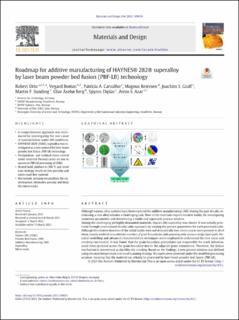| dc.contributor.author | Otto, Robert | |
| dc.contributor.author | Brøtan, Vegard | |
| dc.contributor.author | Carvalho, Patricia A. | |
| dc.contributor.author | Reiersen, Magnus | |
| dc.contributor.author | Graff, Joachim Seland | |
| dc.contributor.author | Sunding, Martin Fleissner | |
| dc.contributor.author | Åsebø Berg, Olav | |
| dc.contributor.author | Diplas, Spyridon | |
| dc.contributor.author | Azar, Amin Shahrestani | |
| dc.date.accessioned | 2022-05-09T07:56:51Z | |
| dc.date.available | 2022-05-09T07:56:51Z | |
| dc.date.created | 2021-05-10T17:31:26Z | |
| dc.date.issued | 2021 | |
| dc.identifier.citation | Materials & Design, 2021 (204), 109656, 17 | en_US |
| dc.identifier.issn | 0264-1275 | |
| dc.identifier.uri | https://hdl.handle.net/11250/2994678 | |
| dc.description.abstract | Although various alloy systems have been explored for additive manufacturing (AM) during the past decade, introducing a new alloy remains a challenging task. Most of the materials require iterative builds, for investigating numerous parameters and determining a viable and repeatable process window.
Among the challenging yet highly demanded materials, Haynes 282 superalloy was chosen. It was initially processed through conventional density cube approach, by varying the process parameters for each processed cube. Although the relative densities of the initial builds were not dramatically low, micro-cracks were present in all of them, mostly evolved on a selective number of grain boundaries and spanning only across a single laser path. Detailed modelling and advanced characterization techniques were employed to understand the root cause and cracking mechanism. It was found that the grain boundary precipitates are responsible for crack initiation, amid stress gradient across the grain boundary due to the adjacent grain orientations. Therefore, the failure mechanism is determined as ductility-dip cracking. Based on the findings, a new process window was defined using elevated temperature and novel scanning strategy. No cracks were observed under the modified processing window, meaning that the material can reliably be processed by laser beam powder bed fusion (PBF-LB). | en_US |
| dc.language.iso | eng | en_US |
| dc.publisher | Elsevier | en_US |
| dc.rights | Navngivelse 4.0 Internasjonal | * |
| dc.rights.uri | http://creativecommons.org/licenses/by/4.0/deed.no | * |
| dc.subject | Micro-crack | en_US |
| dc.subject | Superalloy | en_US |
| dc.subject | Additive Manufacturing (AM) | en_US |
| dc.subject | Powder Bed Fusion (PBF) | en_US |
| dc.subject | Haynes 282 (H282) | en_US |
| dc.title | Roadmap for additive manufacturing of HAYNES® 282® superalloy by laser beam powder bed fusion (PBF-LB) technology | en_US |
| dc.type | Peer reviewed | en_US |
| dc.type | Journal article | en_US |
| dc.description.version | publishedVersion | en_US |
| dc.rights.holder | © 2021 The Authors. Published by Elsevier Ltd | en_US |
| dc.source.pagenumber | 17 | en_US |
| dc.source.volume | 204 | en_US |
| dc.source.journal | Materials & design | en_US |
| dc.identifier.doi | 10.1016/j.matdes.2021.109656 | |
| dc.identifier.cristin | 1909288 | |
| dc.source.articlenumber | 109656 | en_US |
| cristin.ispublished | true | |
| cristin.fulltext | original | |
| cristin.qualitycode | 1 | |

